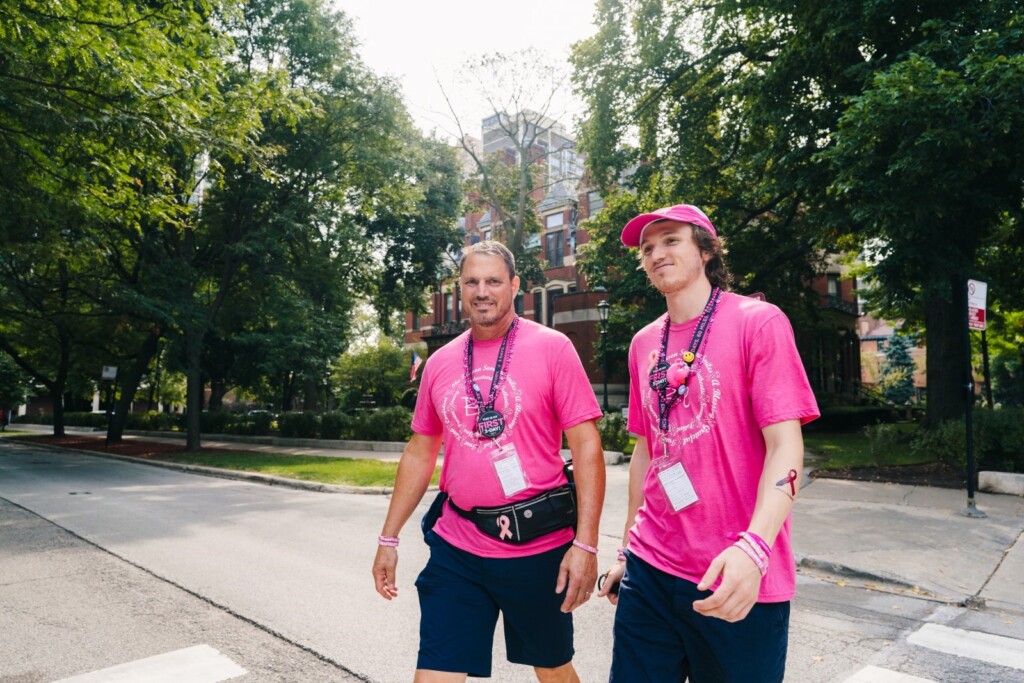As we celebrate fathers and father figures on this special day, let us remember that the fight against breast cancer knows no gender boundaries. It is a collective battle that requires the participation of everyone, and the 3-Day community is proud to unite all in the pursuit of a world without breast cancer. Today, we’re highlighting male breast cancer statistics and information in honor of the men in our Pink Bubble family, whether walking or crewing, who support the fight against breast cancer.
While the gifts of material possessions or experiences are an easy enough way to convey how much we care about the fathers in our lives, the gift of knowledge can be more impactful.
One crucial piece of knowledge that it’s important to convey is the fact that men can, and do, have breast cancer. It’s understandable why men are often overlooked when it comes to breast cancer but, despite many physical dissimilarities, men, just like women, are born with breast tissue. That means that men are also susceptible to breast cancer.
Although the numbers, when compared to women, are low, 1 in 833 men will still come face to face with a diagnosis that will change their lives.
There are some realities that are true for all men, like the median age of diagnosis being higher than it is for women, or that it’s probable that men are less likely to report signs or symptoms of illness. But there are other aspects of the experience that are unique to different populations, like the fact that non-Hispanic Black men have the highest rate of incidence and tend to be younger than white men when it comes to being diagnosed, and non-Hispanic Asian and Pacific Islander men have the lowest rate of incidence. Age, physical activity, diet, health history, etc., all of these can majorly influence the ways in which the men closest to us might come face-to-face with this disease.
In 2023, 2,800 new cases of invasive breast cancer will be diagnosed in male patients. Even with this in mind, the disease is, by and large, considered by many to be a women-specific issue. The shame and lack of awareness contribute to men missing or ignoring the warning signs, delaying medical intervention, and postponing care. One of the best ways to combat this culture is through education. Being mindful of things like one’s family history of cancer, genetic determinants such as BReast CAncer 2 (BRCA2) and Klinefelter syndrome, and lifestyle can all help make sure the men closest to us live lives as healthy and fruitful as they can.
Here are 5 things every man should know about breast cancer:
- Breast cancer in men usually occurs between the ages of 60 and 70.
- Among all men, black men have the highest incidence (new cases) of breast cancer.
- When self-examining, look for a painless lump or thickening in the chest or armpit.
- It’s recommended that men know and understand their risk.
- Annual exams can save your life.
If you’re able, take some time this year to check in with the fathers you know. It’s understandable that these conversations might be uncomfortable, but Susan G. Komen is ready to provide resources that will give you the information needed to speak knowledgeably. Take a look at some of the links below and share them with those in your circle.
The 3-Day’s ultimate goal is to help manifest a society in which breast cancer is a thing of the past. And while we walk for the many people who’ve helped shape us into who we are, a society truly free of breast cancer includes men as well. All of us, regardless of gender, deserve to invest in and benefit from, a world where this affliction is rendered powerless.
We are a stronger, more vibrant community thanks to those we call “Papa,” “Pops,” “Gampy” and everything in between. To all the dads out there – especially the ones who are in the fight and to those serving as caretakers – happy Father’s Day!
Check out more resources from Susan G. Komen here:
Support Services Help Men Cope With A Breast Cancer Diagnosis




